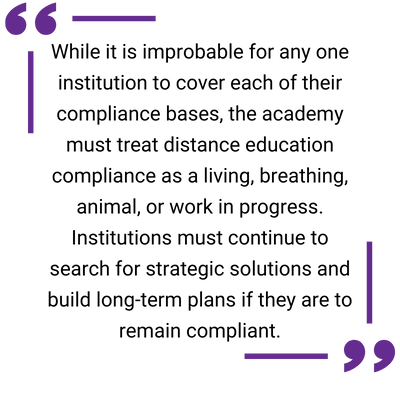In Their Own Words: An Introspective Look at State Authorization Compliance Professionals
Published by: WCET | 6/29/2023
Tags: Distance Education, Professional Development, SAN, State Authorization
Published by: WCET | 6/29/2023
Tags: Distance Education, Professional Development, SAN, State Authorization
As a membership organization made up of nearly 900 institutions across the United States, the SAN team considers it of the upmost importance to provide opportunities for our institutional colleagues to share the unique experiences of working in compliance at their respective institutions. It is in this spirit that we invited a select number of individuals to participate in a brief interview that serves to better understand the unique complexities of those working in State Authorization Compliance at Historically Black Colleges and Universities (HBCUs), Minority Serving Institutions (MSIs), Tribal Colleges and Universities (TCUs), and small or faith-based institutions (those with less than 10,000 students). We consider this to be important to the advancement of the knowledge surrounding State Authorization and Interstate Compliance Professionals.
We are pleased to share the themes, thoughts, and insights that were gleaned from those who participated in our interviews. We sincerely thank the participants for taking the time to share their wisdom and experiences with us and find their contributions greatly valuable. We would relish the opportunity to hear from more of our colleagues. Please feel welcome to contact Dr. Jana Walser-Smith (jwalsersmith@wiche.edu) or Kathryn Kerensky, J.D. (kkerensy@wiche.edu) if you are interested. We present to you several major themes that emerged from our interviews and have included quotes and comments from our interview participants below and refer to them by their chosen pseudonym.
Agency is a key concept that plays a significant role in distance education compliance. For the purposes of this work, we refer to agency as the ability of the compliance professional to take control of the decision-making process as it relates to the compliance requirements at their respective institutions. When institutions and institutional leadership foster a sense of agency, it empowers compliance professionals and facilitates their sense of ownership as it relates to programmatic planning, problem-solving, and even plays a crucial role in ensuring student success.
The concept of “having a seat at the table” is also vital for success.

This means being included in important decision-making meetings and having a say in the direction of the institution. Without a seat at the table, employees can feel undervalued and unimportant, leading to low morale and high turnover rates.
As such, several of the participants expressed concern about their lack of agency and/or voice. Others expressed frustration at simply not having a seat at the table. Most agreed that all institutions must understand and embrace the concept of agency.
One of our interviewees, Reese, suggests that “Senior leaders should bring [us] to the table as it would help the institution be more proactive and less reactionary.” April, another participant, finds that “not being a part of the bigger picture makes us feel like we are “not doing [our] job in its entirety”.
April also expresses additional frustration when not being invited to critical meetings. She explains, “…because we are [are not invited] we are missing out on so much information” and “…all compliance staff, would benefit by being brought into these conversations so that they are able to do their jobs effectively”.
In recent years, as leaders in the academy have been exploring new ways to foster growth and innovation within their organizations, one approach that has gained significant popularity is the concept of a buy-in culture. Buy-in culture refers to the degree to which employees are committed to the vision mission and values of the organization. When an employee has a strong sense of buy-in they are more likely to be invested in the success of the organization and to work collaboratively towards common goals
State authorization/distance education compliance has become an increasingly important topic in recent years, as institutions continue to face an array of legal and regulatory requirements. However, achieving and maintaining compliance is not a simple matter of ticking off boxes on a checklist. Rather, it requires a cultural shift within the institution, one that is heavily dependent on the idea of faculty buy-in. Thus, the importance of senior leadership, faculty, and staff buy-in/support in academia is not only vital for student success but also imperative if institutions are to remain viable and ensure sustainability. This buy-in plays a crucial role in the success of both students, faculty, and staff.
Faculty buy-in refers to the degree to which faculty members are willing to embrace and actively support compliance efforts. Without this support, compliance initiatives are likely to fail or fall short of their full potential. This is critical, as faculty members play a crucial role in shaping the culture of an institution. Their attitudes and behaviors can either facilitate or hinder compliance efforts.
One of the key challenges in achieving faculty buy-in is overcoming resistance to change. Many faculty members may view distance education compliance as an unnecessary burden that distracts from their core academic duties. Faculty may also be skeptical of compliance initiatives that are perceived as bureaucratic or top-down.
When asked about this topic, interviewee Blaine, reports that on his campus, “…faculty buy-in can be challenging”. He added that “… to gain buy-in, you must constantly work with faculty members to provide examples” of the benefits that implementing well-developed compliance programs offer.
Reese echoes a lot of that same sentiment when noting her efforts at her institution, “It feels like [much of my work] is trying to get buy-in and getting people to get on board”. She includes that at the center of her success is “…getting faculty champions to help spread the message because other people in the department take what other faculty say it better than administrators”. “It matters a bit less how much you know and how good you are with people”.
In recent years, leaders in the academy have been exploring new ways to foster growth and innovation within their organizations. As such, the importance of leadership buy-in in higher education cannot be overstated. If leaders are not supportive of change initiatives, then it is unlikely that their subordinates will be motivated to implement the changes. Contrarily, if leaders are fully committed to change, their enthusiasm and motivation are likely to trickle down and result in a swifter change.
April expressed frustration with the lack of leadership support when recalling a situation wherein she advised her leadership team on a significant change that was on the horizon for distance education compliance. April recalls that her leader discounted and discredited her interpretation of the new regulations by reaching out to a peer institution to better understand how they were approaching this situation. Once it was determined that the peer institution had no immediate plans to react to the new guidance, April was advised that because their sister institution was not addressing the situation, “neither should she.”
When discussing support, another participant, Babs acknowledges that enhanced leadership support could improve the state authorization role at her institution as well. She explains that her charge would benefit from leaders who “build time into their schedules to meet with the compliance person(s) and support the organization of a compliance team”.

According to Reese, “Trying to stay close to leadership and making sure that [her voice is heard] since I am not at the table is exhausting”. She also describes how she makes the extra effort to ensure “that I am on their calendars, in their inboxes, asking questions, and asking for meetings because compliance needs that leadership connection.” Reese notes how her role would be improved if senior-level administrators would bring her to the table, saying “even if there is not a big [title] change, just add me to the invite. [Leaders should] consider me the online campus, consider me a location, treat me as like those other campuses and locations are treated. Be more proactive and less reactionary.”
Contrarily, while some distance education professionals struggle to have voice and agency, we found that several participants who held titles such as Manager, Dean, Director, etc., had more autonomy to make critical decisions and were provided greater visibility to senior-level leaders (versus those who were deemed to be analysts, specialists, coordinators, or compliance managers).
Specifically, in some instances, these individuals were permitted to advise, counsel, make recommendations, and even guide senior-level administrators on specific compliance regulations versus those who were deemed to be analyst, specialist, coordinator, or compliance managers. For example, Jess, a director, explains how she was “allowed to establish, create, and cultivate partnerships and collaborations.” She understands that while “Each campus culture is different, cultures are based on relationships and collaboration. We all must realize that “these are the people you need to get to know to get what you need.”
Jess offered that to be successful, we must “Create a process to have check-ins to look into whatever you need to check-in so you can prepare to complete things such as the annual renewal application”. “I pulled together meetings with Deans, financial, legal, etc.”. “I even established a [compliance] counsel that met twice, but timing became a challenge.”
Jess spoke of the importance of getting a [compliance] counsel active and meeting regularly. She advises that compliance professionals must feel empowered to, “start a process. Keep the website updated.” Leaders must provide the compliance team with “the leeway to set that process and [they must] also take the time to introduce them to the people they need to know.”
In the ever-evolving landscape of higher education, the concept of agency, empowerment, and buy-in continue to be critical factors that impact an institution’s success. While all participants agree that progress has been made, collectively, they contend that empowering compliance professionals, ensuring support and agency, not only equips individuals with the necessary tools and resources to make decisions and take action, but doing so would also lead to increased efficiency, productivity, and job satisfaction.
There is a myriad of regulatory and legal requirements that colleges and universities must adhere to. As such, remaining compliant is not an easy task. It requires a thoughtful and carefully planned effort for a compliance program to facilitate a comprehensive compliance initiative. However, building this type of costly initiative continues to be a major challenge for Minority Serving Institutions (MSIs), as they regularly face limited funding. This funding disparity is often a direct result of decreases in state appropriations and/or changes in federal student aid programs. However, even as these institutions regularly receive less funding compared to their Predominantly White Institution (PWI) counterparts, they are expected to generate the same results, (mainly improving student outcomes). This, in turn, makes it difficult for the MSIs to fund support and non-academic services.
Jess explains that as an HBCU in a state-run system, “We are expected to operate just like all the other institutions, just like the flagship. Yet we are expected to do so with less resources. Just based on the funding model we’re always going to be underfunded.”
The issue of funding continued to persist across multiple interviews. Coco, another interviewee participant, warns, “we need funding support. We have to train all these people so that they provide the best opportunities for students” and it takes money to do it.
Consequently, compliance-related programs and initiatives tend to take the brunt of the shortage, as it is typical for these programs to have a smaller workforce/lower staffing levels. This results in a lack of time, staff, and other resources that staff feel imperative to be the most effective in their roles. Accordingly, staffing issues throughout the academy have become a growing concern in recent years. An example exists in the fact that 85.7% of the professionals interviewed for this project had compliance teams consisting of only one individual. The majority of our interview participants were not full-time compliance staff but were in the position of directors or managers who were assigned to do state authorization in addition to their other job responsibilities. In fact, the “team of one” premise was a fervent commonality, as Jess told us, “I am still a team of one when it comes to state authorization.”
She continued by explaining that due to the lack of manpower and time constraints, she often spends less than 5 percent of her working time on state authorization compliance issues. “l use my [state authorization] time to double check and ensure that we are compliance; I then try to confirm that there aren’t any issues.”
Angel piggybacks on this concern. Angel is also a team of one when it comes to state authorization and has been able to make it work but believes there is room to grow. A key to such growth is the work Angel is doing to get senior administrators more involved in understanding the implementation, growth, and competition in online education.
Angel suggests, “The ideal thing would be [to have] more people but realistically won’t happen as quickly. In the interim, you learn to be resourceful and request those resources.”
Blaine confesses that if he had more time to dedicate to the role, he would be more effective. He even questions whether this compliance role should live in his department, “I believe that the state authorization compliance role should be [placed] with another compliance officer since it’s not the only compliance task the university has to do…I don’t think that I am doing the role the justice it deserves. For example, the professional licensure program information is not in this office, the responsibility is with the departments. The departments do all of the advising on whether it meets the requirements for the licensure. While I work with them to make sure that their information is up-to-date and then links out to their sites, they complete the huge amount of research that is involved. It’s a huge thing they try to knock out with less time.”
Jess had a similar experience, adding that “I had originally hoped that someone in Legal would take it over [the state authorization compliance responsibilities]”. At one point they started attending webinars and workshops but it [state authorization compliance] still remained my responsibility.”
Many at the institutions we interviewed contend that compliance action tends to be reactive (and not proactive), specifically as it relates to new regulations. Some believe this has a direct correlation to understaffing. It was noted that often an institutional response was the result of a worst-case scenario occurrence and seemed to never be a result of long-term planning.
For example, Angel agrees that state authorization should be a standalone position due to all the intricate details and research it takes to understand the requirements and internally educate fellow institutional colleagues and departments on the requirements.
Jess echoed the sentiment, stating, “we need personnel even if it is part-time” so that someone can focus on the work year-round rather than at key points in the year (ex. SARA (State Authorization Reciprocity Agreements) renewals). Given that Jess has multiple responsibilities on top of state authorization, they find it important to prioritize the most essential obligations and meetings, such as State Portal Entity (SPE) meetings/webinars, and due dates like SARA renewals and data reports.
Babs shares, “I would love to be able to create the dream team of compliance because those conversations would open the ability to have more clout because one challenge is convincing others that we can’t step around compliance. [For our leaders] “It’s easy to say, “This is for students,” or “This is laws and regulations,” or “This comes with a fine or adverse action.” However, it’s hard to convince others, those dreaming up offering their programs across state borders to stick with it!”

To varying degrees and for various reasons, staff turnover presented a challenge to our participants as well. Angel notes that at her institution there have been lots of leadership changes and she finds it because they “have to go back to square one” and explain state authorization and compliance again to new leadership. Although a challenge, Angel has found that leadership likes to be kept in the loop and that the more knowledgeable leadership is, the more they may be able to support the compliance role.
Related to change, April discussed how communication presents a challenge in their role at their institution. As April is not in a leadership role, they have found that they are not kept in the loop when processes or procedures that impact their work change, which has resulted in them having to redo tasks.
Even as the overall growth of state authorization compliance obligations in higher education has been well documented, funding and workforce limitations have seemingly hindered or slowed progress. While it is improbable for any one institution to cover each of their compliance bases, the academy must treat distance education compliance as a living, breathing, animal, or work in progress. Institutions must continue to search for strategic solutions and build long-term plans if they are to remain compliant. However tactically, participants agree that more institutions must work fervently towards building a true culture of compliance.
Despite any challenges compliance staff may face, a common trait they all shared is passion, whether it be for their institution, job, the students, or all of the above. Blaine said they “really enjoying working here [at their institution] because I know what this institution has meant for this population [of students].” Angel stated that they love “the cultural aspect” of their institution and job, explaining that “there’s a family feeling that’s shared here. When you become a part of the institution, you’re a part of that family, and it’s to your advantage to share that. You want to share that part of you with others.” Similarly, Coco’s favorite part of their job is “the sense of community and the opportunity to make things better.”
The staff’s passion for students was palpable throughout the interviews. Despite having a challenging or sometimes frustrating experience in their role, April stated that “students keep me going. It’s always been that way regardless of the role or capacity I’m in.” Babs felt that it’s honorable that the mission of their institution was recently renewed to be more inclusive and “calls us to be responsible for ourselves and others.” Babs stated that “it feels good to be working within a community with that kind of care woven in.”
Along with that passion is a strong sense of community and collegiality. All participants seemed genuinely interested in sharing knowledge and resources with those at their institution and with their colleagues at other institutions.

We asked what advice they would give to someone starting out in state authorization or struggling to get launch their programs:
Despite the challenges faced, our participants illustrated the various ways that have approached such challenges and the solutions that they have found the most effective in their work.
Regardless of the individual’s institution, title, or perspective, a common theme among our interviewees was the importance of resourcefulness, of both the compliance staff member and the institution in general. According to April, she would advise compliance staff members to “be a go-getter” and to be persistent less some doors close. Similarly, Angel stated that compliance staff need to be “very resourceful, resilient, and patient” and “learn to use your resources including those at your institution and those at other institutions.” Jess echoed these sentiments, stating that compliance staff must be “able to be very resilient” because they are “expected to operate like all the other institutions” but “with less resources.” This has resulted in Jess and her institution “learn[ing] to do more with less.” The lack of resources and need for resourcefulness has in many instances built a sense of camaraderie and support in other ways. Jess mentioned that she felt her institution would support the hiring of additional staff if not for the lack of funding and having this recognition has helped keep her grounded.
Across the interviews, regardless of institution or the individual’s role, our participants highlighted the importance of building and sustaining relationships as key to success as a state authorization compliance professional. Reese believes that the most important things are to “engage politically, be collaborative, and be a good communicator” and that “it matters a bit less how much you know and more how good you are with people.” April agreed that it is extremely important to build rapport with everybody who can be directly impacted with state authorization. To April, creating “those relationships with those who are going to be integral pieces of your state authorization work” is “extremely important.”
Jess would advise new staff to prioritize “partnerships and collaboration first.” To Jess, even if campus cultures differ, those cultures are “based off relationships and collaboration” and it is important to understand such and get to know people that you need to work with. Jess advised that compliance staff should “create a process to have check-ins” with those key individuals to do the work that needs to be done. Coco believes it is “very imperative to be an active listener” and that “being an active listener provides an opportunity for mutual understanding and allows for engaging communication.”
It goes without stating that this work requires dedication, collaboration, commitment, and institutional support. Often, distance education compliance professionals are also engaged in multiple (additional) duties/responsibilities, while simultaneously remaining vigilant about this work. Most importantly, these individuals carry out and successfully complete this work despite difficulties and obstacles.
It was evident with each of the interviews that all participants were not only consummate professionals, but also champions of this work. All were gracious with their time, honest with their responses to the questions asked, and refreshingly open when recalling their lived experiences.
We cannot convey enough how grateful we are to our interview participants for sharing their knowledge with us. We hope that readers have learned more about the perspectives of their institutional colleagues and have found similarities in their own experiences.
Director, Interstate Compliance and SAN Member Outreach, State Authorization Network